
The dead man’s drum-shaped coffin emerges from the matrimonial bedroom where he has “slept”, preserved in formalin, with his family for the last eight months. Now he has left the house, he is finally dead, his soul winging its way towards the afterlife.
“Not really,” I say. “People are always buried within about a week of their death. Normally we put them in the ground. Sometimes we burn the bodies.”
As if sensing that one of their souls will shortly follow the dear departed, the pigs, hogtied with strips of bamboo bark in the noonday, equatorial sun, reach a crescendo of screaming.
“What do you sacrifice?” he asks.

“We don’t have sacrifices in England,” I say.
“Not even a chicken?” he asks, clearly shocked and politely disapproving that our dead could pass into the afterlife unescorted by even the lowest of creatures.
“Not even a chicken,” I say, apologetically, thinking of the sandwiches, cocktail sausages, olives, quiche and French fizz at my grandmother’s funeral eighteen months ago and a world away.
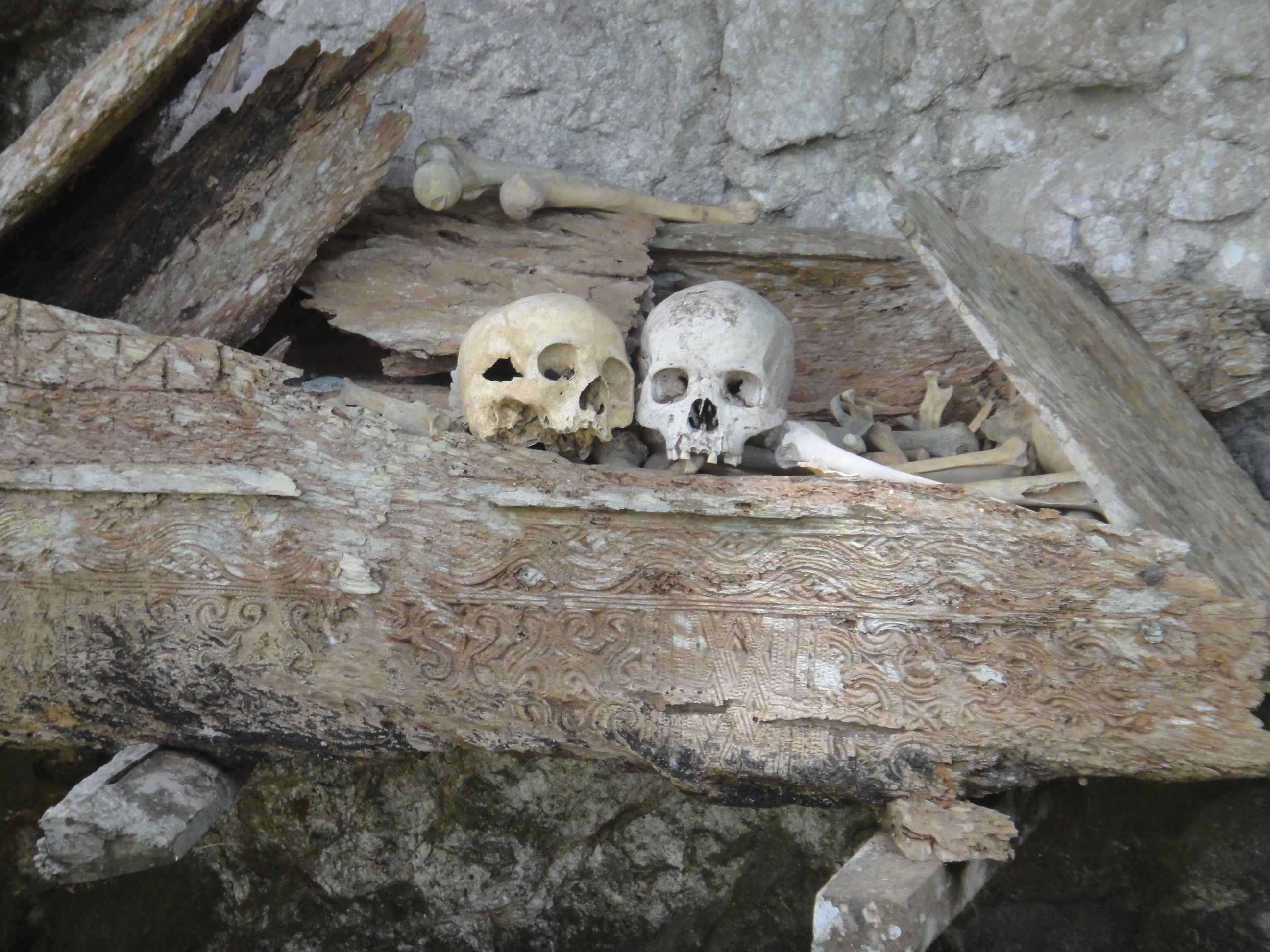
Like my grandmother, though, like the deceased, like the other funeral guests, and like the folk whose bodies lie below the hanging graves in the nearby village, my interlocutor is a practising Christian.
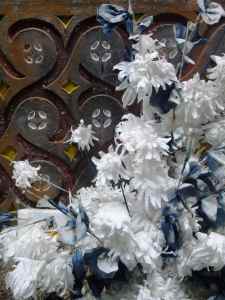
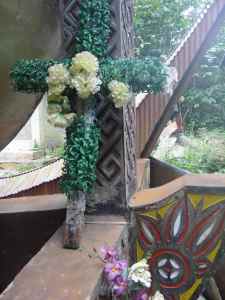
Here in the dazzling highlands of south central Sulawesi, where jagged mountains fling out green hills like flying buttresses, rice terraces tumble like mirrored staircases and surrealist outcrops jut from the hilltops, pretty much everyone is Christian, in fact.
The Muslim evangelists who swept across the Indonesian archipelago shortly before the Portuguese arrived half a millennium ago never reached this far into the interior. So the Toraja followed their old beliefs and rituals unmolested until well into the twentieth century.
Then Protestant missionaries, with a mental athleticism almost Jesuitical in its genius, managed to paste the Good Book over the existing animist framework.
Just, in fact, as their antecedents pinned Christmas onto the Roman festival of Saturnalia and the druidic ceremony of Yule, and painted Easter carefully over a myriad spring fertility rituals.

Along the main road, where scooters whiz and bemos roar, there are almost as many little churches as there are tongkonan houses, their roofs curved dramatically like the boats which, the Torajans believe, brought their ancestors over the sea from Indochina.

And the crocodile of female relatives who process past the 40-odd bamboo structures erected to house family members over the week or so of the funeral are dressed in good Christian garb.
They bear token gifts of coffee, tea and biscuits, covered with purple doilies, into the family reception room.
Their menfolk carry the larger gifts – the pigs, the plastic jerry cans of palm wine and rice hooch – up the hill on bamboo poles.

Others lead their highly prized buffalo, with quiet, or more obtrusive, pride. I mean, if you’d spent three years’ wages on a buffalo for the slaughter, would you laugh or cry?

The dead man’s beautiful grandchildren form the reception line, fidgeting in beads, silk and turbans like so many pages and bridesmaids at a Western wedding: last-minute wardrobe adjustments included.

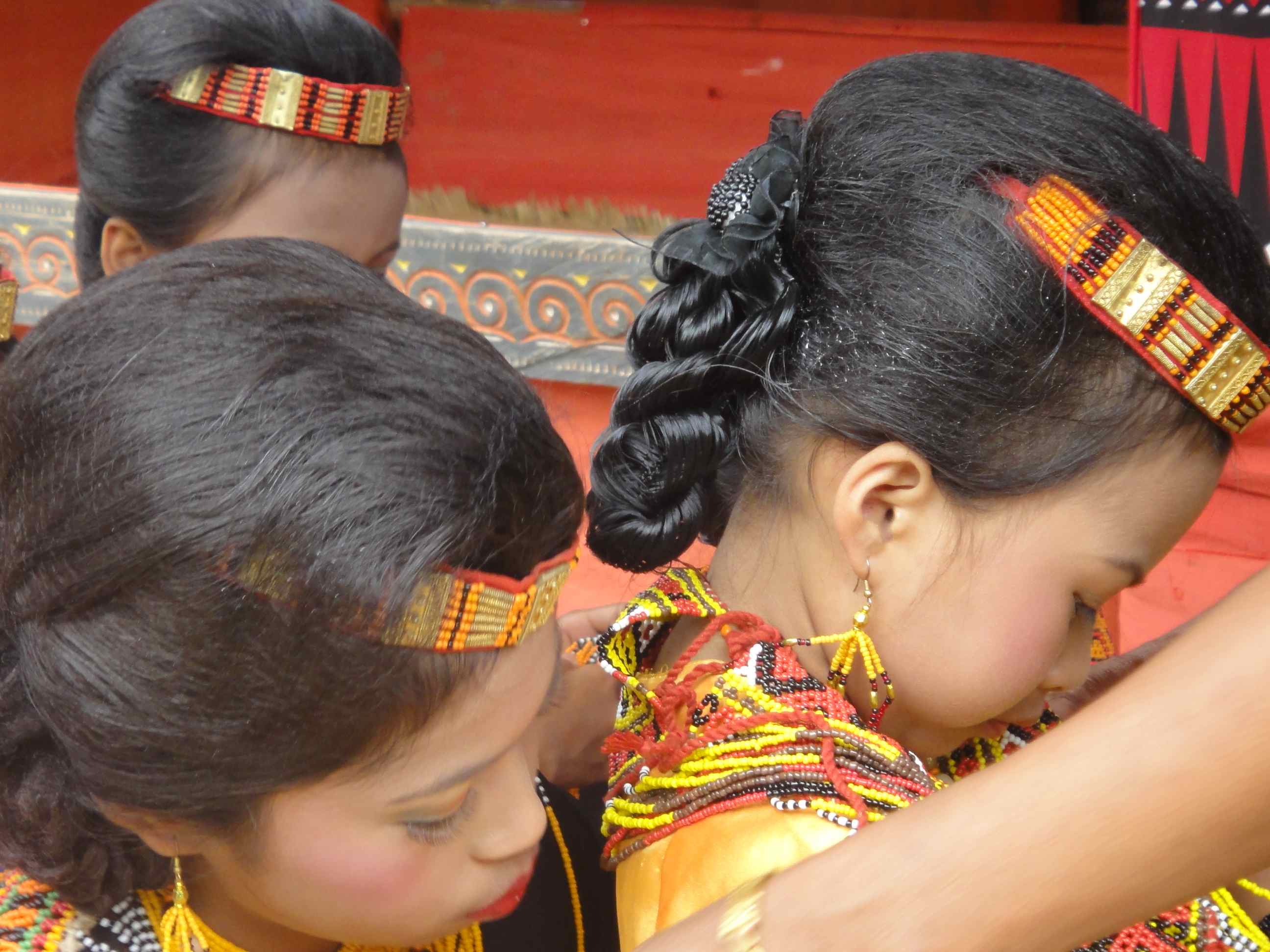
Men bring the conventional token gift of a carton of kretek (clove cigarettes), sometimes in elaborate boxes, other times (as we did) in black plastic bags. Though a couple of the older mourners wear solemn expressions, the atmosphere is more festive than funereal.
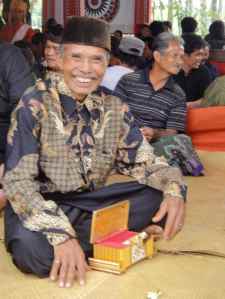

It’s a celebration. A good show. Months of planning and crippling financial investment reach its culmination in days of processions and ritual.
Not only what the dead man would have wanted. But what he worked his entire life to achieve.
It would be fair to say, however, that the nine year old does not entirely appreciate this masterclass in comparative religion and ethnology. He is concerned by the condition of the pigs.

Some of them are foaming at the mouth. Others urinate and defecate uncontrollably. Immobilised by their bamboo carrying poles, dumped on the ground like so many sacks, they alternate between panicked screaming and a desperate panting.

This prize sow will, apparently, be spared the coming holocaust. Which is why someone has covered her in rattan leaves, a token attempt at shade.
“This is making me nauseous,” Z says. “Can we go yet?”
“No,” I say, pompously. “This is a once in a lifetime opportunity to see an authentic animist funeral. We can go after the sacrifices.”
“Mum…” he says.
“Have you ever seen a buffalo sacrificed?” I ask.
“No,” he says.
“Me neither,” I say. “So we should. But you don’t have to look if you don’t want to.”
Z has done really well, in fact. He’s eaten lunch (plain boiled rice — after a look at his expression when confronted with the pork, I explained in my pidgin Indonesian that “Child Eat Boiled Rice. No More. Thank You. I Eat. Very Good. Good good!” ). And he has done so using his right hand, not his left.
Two strapping chaps begin to dig a hole in the ground, in front of the decorative rice barns under whose porticos the elite guests sit.
“I really don’t like this,” Z says. “Do you see that buffalo there? He’s got blood coming out where the ring goes through his nose.”
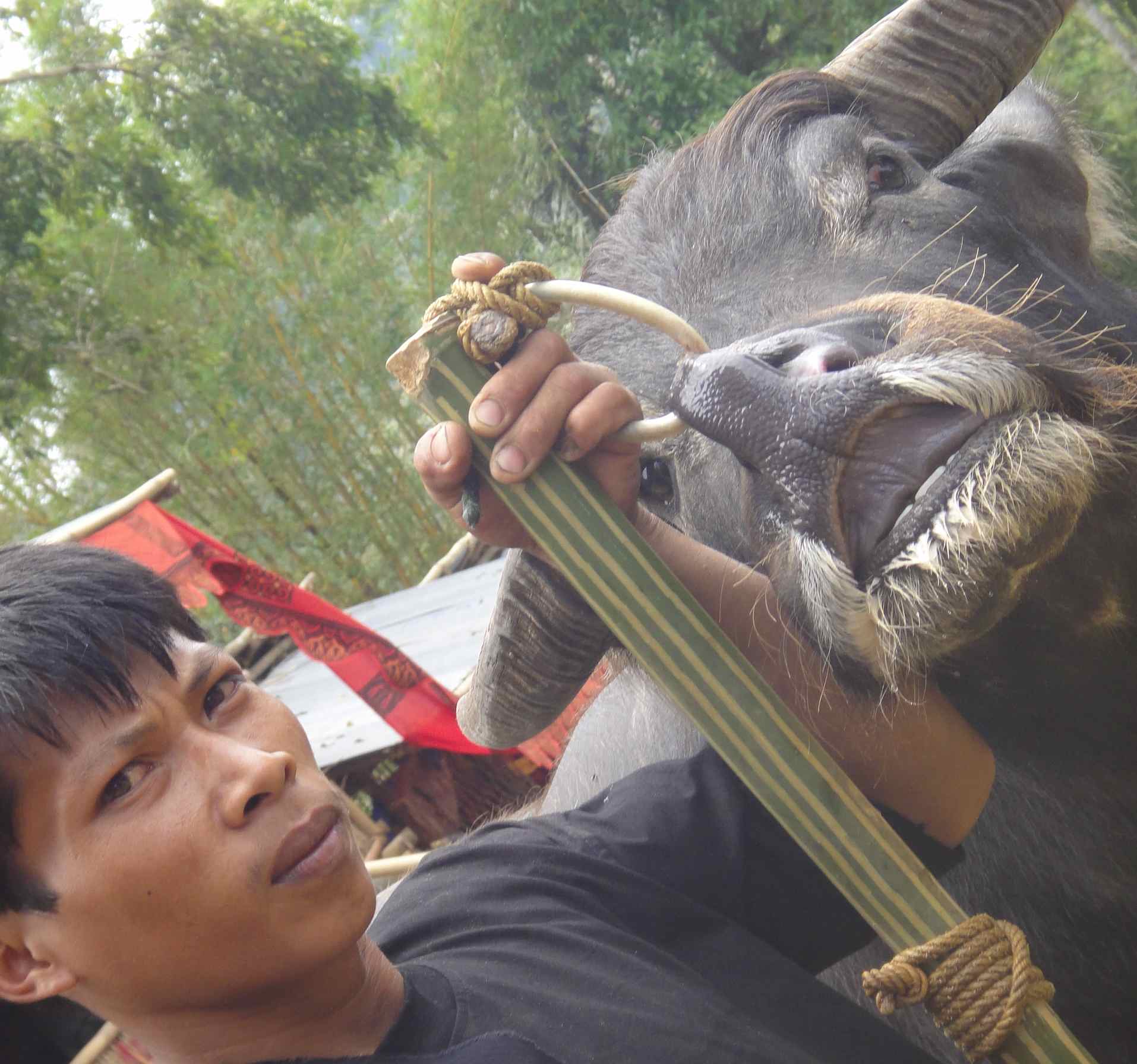
Torajans reckon their wealth in buffalo. Even an entry-level bovine costs thousands of dollars: a blue-eyed, albino version will sell for around 250 million rupiah (or well over 25 thousand US dollars). More than the price of the most elaborate tongkonan and many times the price of the car.
Throughout their lives, they work to amass these precious creatures, and tend them with a deep affection. Not necessarily as rice farmers, any more, though this is how the dead man acquired the wealth demonstrated for the first time at his funeral and the rich soil of the highlands supports three rice harvests every year. Today, they could be computer repairmen, teachers, motor mechanics, tour guides…
Then, as family members die, the buffalo are sacrificed, in an epic of conspicuous consumption and family togetherness that puts the average Western wedding quite to shame.
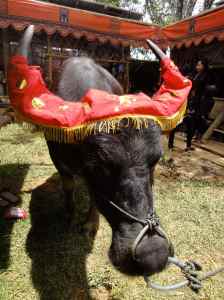
Bill, the dead man’s Australian son-in-law, up from Jakarta for the occasion and resplendent in black shirt and black funeral sarong, has invited us for coffee and tea.
“I’m sorry for your loss,” I say, rather awkwardly, given that we are here, essentially, to gawp.
“It’s alright,” he says. “He’s been dead since December, so it’s pretty much in the past.”
“December?!” I say.
“Yeah,” he says. “They’ve been getting together the money for the buffalo. It takes months to do that. Sometimes years. They’re expensive things, buffalo. And people round here don’t earn much. I bought three of them,” he adds, wryly. “I mean, my wife did…”
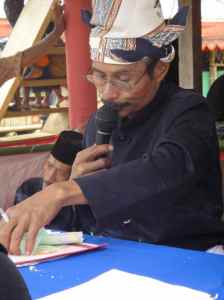
The MC continues his perorations, reciting the gifts brought and the names of their donors, inscribing each on old-fashioned carbon duplicate forms.
The local Protestant pastor will show up later in the day, after the sacrifices are safely complete and before too many of the jerry cans of palm wine and rice spirit have been drunk, to give a form of eulogy. I imagine a character straight out of Anthony Burgess’ Malayan Trilogy, returning home to gin and obliteration at the hopelessness of his flock.
A handler brings forward one of the ten or so buffalo which scatter the grounds, stroking his forehead and murmuring soothingly. The diggers produce the widest bamboo pole I have ever seen – almost a foot in diameter, I would guess.
At the sight of engineering, Z’s colour lifts noticeably.
“Oh,” he says. “Do you think they’re digging the hole to put the stake in?”
“I reckon so,” I say.
“I think that’s the buffalo they’re going to sacrifice, don’t you?”
“Yep,” I say.

The chaps secure the bamboo pole with three wooden stakes, each three or four inches in diameter. A screaming pig is unceremoniously dumped on the ground behind the pole, where it squawks and grunts itself into submission.
Another procession of women files past. The women of this branch of the family are wearing lilac tops. Rather, I think, like bridesmaid’s outfits in the west.
The concept of family in the Toraja is an extensive one: a better translation might be “kin” or “clan”. It encompasses everyone up to grandparents (their siblings, their children, and their children’s children), and everyone below that.

The dead man was ninety-four with nine surviving children of his own from a sequence of wives. The relatives have invested in a ton and a half of rice to feed guests over the week, and round the back of the guest constructions guys are killing, singing and butchering pigs around the clock.

Poorer neighbours have set up temporary stalls under the bamboo guesthouses and on the track leading up from the main road.

Martin, our guide, remarks with ill-concealed envy on the number of buffalo. “He was a very rich man,” he says. “And his children have very good jobs. They’ll probably kill only one today. Another one or two tomorrow. Then seven or eight on the sacrifice day.”
Martin’s father died relatively recently. So he owns no buffalo any more. Although a poor family, they put together a ten-buffalo funeral. But nothing on the scale of this.
It rankles.
The buzz of expectation grows. Now, Z and I both eat meat. Whole-heartedly. Bloody fillet. Bleeding roast beef. Tartares, kidneys, liver…
But, as urban creatures, neither of us has ever seen an animal being killed. The closest we’ve come to the living, bleeding source is the whole sucking pig I bought Christmas one year, which a five year old Z, with absolutely no sentimentality whatsoever, insisted on carrying proudly from the butchers.

Some of the young mourners hold ceremonial axes, like the ones which decorate the balcony of the house. But the guy who performs the sacrifice is not in costume and holds only a butcher’s knife. There is no incantation. I wonder, idly, how this ritual would have looked before the missionaries arrived.
The pig dies first, so quietly and matter of factly I almost miss it. The slaughterer bends down, opens the back of the pig’s neck from ear to ear, and catches the blood in a length of bamboo. The creature does not even have the time to scream before its soul is racing into the afterlife.
Though out in the boiling sun, its fellow swine scream in sympathy.
The buffalo is secured to the stake with a halter that runs to its ankle. His handler strokes his nose and murmurs to him lovingly, soothingly. I think of the hecatombs of Homer’s Iliad, the mass slaughter of hundreds of oxen, the moment when the axe fell…
“You need to move back,” says Martin. “It’s dangerous.”
Dangerous? I think. The buffalo is tranquil, calm, doe-eyed, as slow in its movements as any cud-chewing Anchor cow. In all our time in Asia, I have not once seen a buffalo move at anything other than a snail’s pace.
We move back. And then it happens very quickly.

The handler takes the knife. Whips it across the animal’s neck so fast I cannot see it, and leaps out of the way, cobra-speed. The gash gapes open, filling the air with a fine spray of vermilion arterial blood.

The buffalo rears on its hind legs, gallops the length of its halter at phenomenal speed then stumbles, felled by the rope, onto its side.
There it jerks and spasms, trying hopelessly to rise, the gash widening each time it raises its head, a gush of fresh, well oxygenated blood the colour and consistency of Strawberry Ribena sullying the grass, eyes more doelike by the second, mouth open in a soundless bellow, over a tonne of death writ very, very large.
As Z says, “It’s an ugly sight.”
But it’s mesmerizing, too. One’s gaze is drawn away, then back, away, then back.

Maybe I need to read more Hemingway. But I never knew how long a buffalo takes to die. This one alternates between minutes of quietude, chest juddering, eyes blank, blood leaking from its neck, and moments of active struggle, when it lurches upwards as if galvanised by electricity, Frankenstein-style, while guests carry yet more screaming pigs up the hill.
As the dogs begin to sniff around it, and the pool of blood congeals, the buffalo’s soul passes, finally, into the ether, to carry the dead man’s soul on its journey to the afterlife. Z tugs at my arm. We make our farewells. The funeral will continue for several more days. But he has seen enough*.
Tidak ada komentar:
Posting Komentar